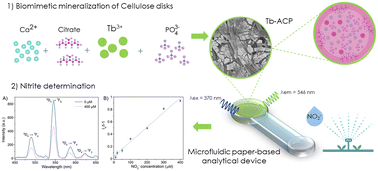In situ biomimetic mineralization of a paper microfluidic device as a luminescent sensor for nitrite determination†
Abstract
Herein, a novel luminescent platform has been designed via in situ mineralization of a microfluidic paper-based analytical device (μPAD) made of cellulose in the presence of Tb3+. Cellulose nanofibers were homogeneously mineralized with Tb-doped calcium phosphate nanoparticles resulting in a luminescent composite material, which exhibits the characteristic green emission from Tb3+ ions, and is stable during long periods of time (6 months). This strong green emission is selectively quenched upon addition of nitrite, thus making the μPAD a potential sensor for the quantification of nitrite, a hazardous pollutant in water. Also, the μPAD presents high sensitivity with a detection limit (10 μM) lower than the permissible limits of nitrite in drinking water (65 μM) and it also displays good accuracy and reproducibility in real water samples. The in situ biomimetic mineralization of paper holds promise for an environmentally friendly design of sensors for nitrite contamination of water.

- This article is part of the themed collection: Nanomaterial applications in water


 Please wait while we load your content...
Please wait while we load your content...